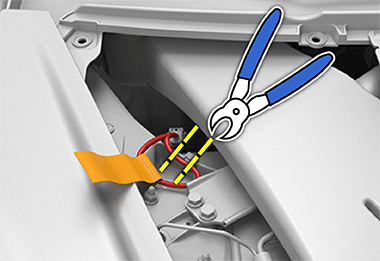Electric Vehicle Components
High Voltage Components

- Heat Pump Assembly
- Front Drive Unit
- Service Access Panel for High Voltage Components (Ancillary Bay)
- High Voltage Battery
- High Voltage Busbars
- Rear Drive Unit
- Charge Port
Note
Plaid version not shown.
Warning
The high voltage system has no user serviceable parts. Do not disassemble, remove or replace high voltage components, cables or connectors. High voltage cables are typically colored orange for easy identification.
Warning
Read and follow all instructions provided on the labels that are attached to Model S. These labels are there for your safety.
Warning
In the unlikely event that a fire occurs, immediately contact your local fire emergency responders.
Charging Equipment
Charging equipment designed specifically to charge your Model S is available from Tesla.
For information on the charging equipment available for your region, go to http://shop.tesla.com.
- A Wall Connector, which installs in your parking space, is the fastest way to charge your vehicle for daily use.
- A Mobile Connector allows you to plug into most commonly used power outlets. When using the Mobile Connector, attach the smart adapter (if required) to the Mobile Connector before plugging it in to the power outlet, and then plug in your vehicle.
- Tesla also offers adapters that allow you to plug into the most commonly used public charging stations in your region. At a public charge station, first attach the adapter to the station's charging connector and then plug in your vehicle.
First Responder Loop
Model S is equipped with a first responder loop in the front trunk that can be double cut to disable high voltage in an emergency situation. Follow these steps to locate the first responder loop and disable the high voltage system.
Warning
Always allow trained first responders to extinguish a vehicle fire and approach a vehicle that may have a compromised high voltage component.
- Open the hood (see Front Trunk).
- Remove the access panel by pulling it upwards to release the clips that hold it in place.
- Double cut the first responder loop to disable the high voltage system.
 WarningAlways double cut the first responder loop to remove an entire section. This prevents wires from accidentally reconnecting.WarningAfter deactivation, the high voltage system requires two minutes to de-energize.WarningEven if you have double cut the first responder loop, ALWAYS ASSUME THAT ALL HIGH VOLTAGE COMPONENTS ARE ENERGIZED! Cutting, crushing, or touching high voltage components can result in serious injury or death.
WarningAlways double cut the first responder loop to remove an entire section. This prevents wires from accidentally reconnecting.WarningAfter deactivation, the high voltage system requires two minutes to de-energize.WarningEven if you have double cut the first responder loop, ALWAYS ASSUME THAT ALL HIGH VOLTAGE COMPONENTS ARE ENERGIZED! Cutting, crushing, or touching high voltage components can result in serious injury or death.